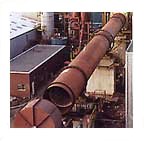Difference between revisions of "Calciner Dryers"
| (2 intermediate revisions by one other user not shown) | |||
| Line 7: | Line 7: | ||
* Please start editing this page after the /noinclude | * Please start editing this page after the /noinclude | ||
* -------------------------------------------------></noinclude> | * -------------------------------------------------></noinclude> | ||
[[File: | [[File:Calciner_Dryers.jpg|thumb|200px|right|Calciner Dryers]] | ||
The '''Calciner Dryers''' are for high temperature processing from 1000°-2100°F with controlled atmospheres utilizing heat sources of gas, oil, and electric. | The '''Calciner Dryers''' are for high temperature processing from 1000°-2100°F with controlled atmospheres utilizing heat sources of gas, oil, and electric. | ||
== | |||
The refractory lined rotating shell has no lifting flights. Forward flow of the material is | They are very similar in design to [[Rotary Dryers]], except that much higher temperatures are involved. Again these may be directly heated or indirectly, depending upon the specific application. | ||
== | |||
Based on the design of the indirectly heated rotary dryer, the calciner is capable of operating at temperatures of 1100°C. Typical applications include: nickel catalysts | |||
== | ==Directly Heated Calciners== | ||
The refractory lined rotating shell has no lifting flights. Forward flow of the material is effected by the slope and rotation of the shell. Located at the discharge end, a gas or oil burner enables temperatures up to 1650°C to be achieved. For certain applications, the atmosphere within the [[Kilns|kiln]] can be controlled to give oxidizing, or slightly reducing conditions. | |||
==Indirectly Heated Calciners== | |||
Based on the design of the indirectly heated rotary dryer, the calciner is capable of operating at temperatures of 1100°C. Typical applications include: | |||
* nickel catalysts | |||
* carbon regeneration | |||
* molecular sieves | |||
* china clay | |||
==Video== | |||
<youtube>2ai9CgvoTFQ</youtube> | <youtube>2ai9CgvoTFQ</youtube> | ||
Latest revision as of 18:40, 1 August 2012
The Calciner Dryers are for high temperature processing from 1000°-2100°F with controlled atmospheres utilizing heat sources of gas, oil, and electric.
They are very similar in design to Rotary Dryers, except that much higher temperatures are involved. Again these may be directly heated or indirectly, depending upon the specific application.
Directly Heated Calciners
The refractory lined rotating shell has no lifting flights. Forward flow of the material is effected by the slope and rotation of the shell. Located at the discharge end, a gas or oil burner enables temperatures up to 1650°C to be achieved. For certain applications, the atmosphere within the kiln can be controlled to give oxidizing, or slightly reducing conditions.
Indirectly Heated Calciners
Based on the design of the indirectly heated rotary dryer, the calciner is capable of operating at temperatures of 1100°C. Typical applications include:
- nickel catalysts
- carbon regeneration
- molecular sieves
- china clay
Video
